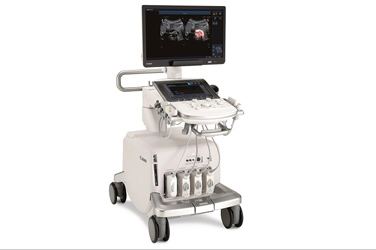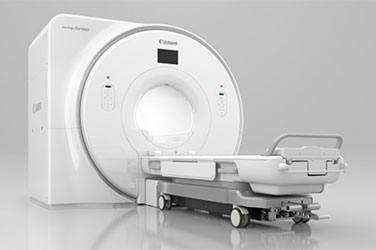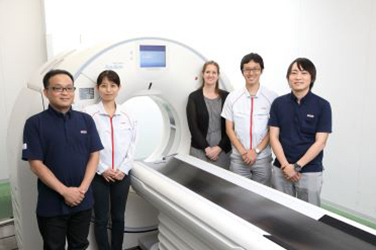

A new technology for objective diagnosis of fatty liver progression
Diagnostic ultrasound system for safeguarding patients’ health through early detection
Ultrasound equipment can help in early detection and prevention of fatty liver. Canon is working closely with doctors to develop a range of technologies to ensure that early signs are not overlooked and left to advance into more serious condition.
July 27, 2023
Identifying hard-to-detect fatty liver in early stages
NAFLD, non-alcoholic fatty liver disease, is an ailment in which fat accumulates in the liver and impairs liver function as a result. It is on the rise in Japan, not because of excessive alcohol consumption, but because of lifestyle factors such as overeating and lack of exercise. It is estimated that more than 10 million people in Japan have NAFLD.
Because it is a disease with few subjective symptoms, it is often detected only when it progresses into a serious stage such as cirrhosis of the liver or liver cancer. Therefore, enabling early detection and prevention of NAFLD has been a vital issue.
Dr. Hiroko Iijima, Specially Appointed Professor at the Ultrasound Imaging Center of the Hyogo Medical University Hospital, is a widely acknowledged expert on liver diseases and has had high hopes from early on for the usefulness of ultrasound in liver diagnosis. Through joint research with Dr. Iijima, Canon developed Attenuation Imaging (ATI), a diagnostic technology capable of detecting with high accuracy early-stage fatty liver that were previously difficult to detect.

Hyogo Medical University Hospital

Hiroko Iijima, MD, Specially Appointed Professor
Ultrasound Imaging Center, Hyogo Medical University Hospital
Dr. Iijima explains the effectiveness of early detection of NAFLD:
“A liver that has become stiff because of advanced NAFLD is difficult to restore to a healthy condition. If you have early fatty liver, however, you can reverse it, or at least slow its progression, through lifestyle changes and other measures. That is why early detection of the disease is so vital, and Canon’s ATI makes that possible.”

Ultrasound Imaging Center at the Hyogo Medical University Hospital where Dr. Iijima is a Specially Appointed Professor
ATI objectively measures fatty liver progression
Conventional ultrasound equipments were thus far unable to quantify the degree of progression of fatty liver. Instead, progression was judged by analyzing contrast that appeared in images, which depended greatly on the technical skills of the person using the equipment and the performance of the equipment itself. Quantifying diagnosis of early-stage fatty liver once required extensive examinations such as MRI.
Dr. Iijima explains: “With conventional ultrasound equipments, doctors and technicians determine based on differences in contrast between images of the liver and those of the kidney and spleen. Advanced fatty liver, in which more than 30% of the liver cells are fatty, is highly diagnosable. However, early fatty liver, in which the fatty change is between 5% and 10%, is so subtle in contrast that it is very difficult for even those skilled in ultrasound diagnosis to make a decision.”

Diagnostic images of fatty liver using ATI
(The attenuation of the ultrasonic pulse in the specified area is shown in color. The equipment achieves displaying the measurement results in numbers by calculating the attenuation coefficient.)
In a 2020 revision, the clinical practice guidelines of Japan defined fatty liver as "a condition in which 5% or more of the liver cells become fatty." However, mild fatty liver with 5% fatty change is quite difficult to distinguish with conventional technology. Thus a new method had to be found in order to enable detection of early fatty liver using ultrasound equipments already in use in many clinical settings.
As ultrasound pulses radiate through the patient's body pass through living tissues, they gradually decrease due such effects as absorption or diffusion. The phenomenon is called attenuation. The ATI developed by Canon was able to measure and digitalize the amount of attenuation by liver cells.
Dr. Iijima, who has a long history of joint development with Canon, describes the effect of the introduction of ATI:
“By being able to display a fatty liver in numerical terms using ATI, even inexperienced doctors and technicians can make appropriate decision. Sharing the numbers with patients also makes it easier for them to see results from lifestyle improvements and exercising, which help them stay motivated.”
Advanced technology—available even in affordable models—protects the health of more patients
Because ultrasound equipment can be used repeatedly to diagnose various diseases without causing harm to the human body, it is used not only at large hospitals but also at local doctors and health check centers. The standard abdominal probe (the part of the sensor placed on the patient's body) can be used for diagnosis by Canon's ATI, so it is expected to be adopted by many facilities.
Prior to the development of ATI, Canon also worked with Dr. Iijima to develop Shear Wave Elastography, a technology capable of measuring the stiffness of the liver and other tissues. As NAFLD progresses, the liver becomes stiff, and the risks of cirrhosis and liver cancer increase. Therefore, it is important to know the stiffness of the liver.
Canon has made it possible to incorporate these two advanced technologies that enable the early detection of fatty liver disease possible in from high-end to affordable models.
Explaining the importance of early detection, Dr. Iijima says:
“I would recommend that health check centers also introduce ultrasound equipment with ATI. NAFLD can be treated well if it is detected early. If it progresses to cirrhosis of the liver, however, there is no effective drug for treating it, making a full recovery difficult.
Fatty liver can also occur in thin people, and therefore cannot be determined solely by one’s appearance. Japanese people in particular are said to genetically be at high risk more often than other ethnicities.
Early detection through regular checkups and examinations at family practices enables treatment to be started as soon as possible, saving more lives.
The early detection of NAFLD is just as important as that of cancer. It is wonderful that Canon's diagnostic ultrasound system can be equipped with ATI in a wide range of models, including widely-used models.”
Canon will continue to respond to the needs of professionals at the front line
Dr. Iijima expresses her high expectations for future advancements in ultrasound equipment:
“I think many Canon engineers are willing to repeatedly visit clinics and other facilities in order to meet the expectations of us physicians.
In the future, I would like to see affordable models of ultrasound equipment with diagnosis-assist function that allow practitioners at health check centers and local doctors to easily operate them and quickly detect suspected cases of chronic hepatitis and pancreatic cancer.”
Canon will continue to listen closely to the opinions and views of professionals at the front line as it develops technologies for safeguarding the health of people everywhere.
Canon will continue to respond to the needs of professionals at the front line
Dr. Iijima expresses her high expectations for future advancements in ultrasound equipment:
“I think many Canon engineers are willing to repeatedly visit clinics and other facilities in order to meet the expectations of us physicians.
In the future, I would like to see affordable models of ultrasound equipment with diagnosis-assist function that allow practitioners at health check centers and local doctors to easily operate them and quickly detect suspected cases of chronic hepatitis and pancreatic cancer.”
Canon will continue to listen closely to the opinions and views of professionals at the front line as it develops technologies for safeguarding the health of people everywhere.




